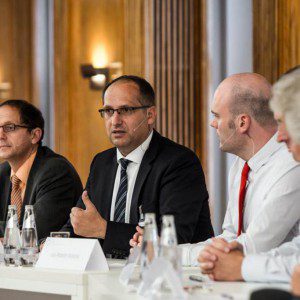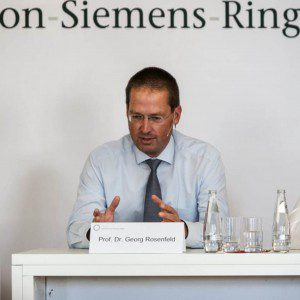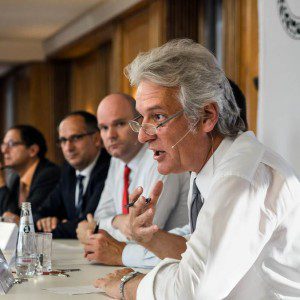Do we have a problem with technology transfer? Well not really. But something does. This could be the quintessence of the Werner-von-Siemens-Ring Foundation's event on 7. September 2016 in Berlin were.
Moderated by Jan-Martin Wiarda, Dr. Ole Janssen, sub-department head at the German Federal Ministry for Economic Affairs and Energy, Dr.-Ing. Thomas Kathofer, Chief Executive of the Federation of Industrial Research Associations, Dr. Andreas Keller, vice-chairman of the German Education and Science Union and Prof. Dr. Georg Rosenfeld, Director of Technology Marketing and Business Models at the Fraunhofer-Gesellschaft the questions of whether we need new bridges for research and technology transfer. Which pillars should probably be rammed in, strengthened or extended??
The core messages of the evening were: Our bridges between science and business are good, but there is still "room for improvement". We should: Strengthen universities for knowledge transfer on an equal footing, involve the more innovation-remote part of the SME sector more, and bring entrepreneurs and researchers closer together through appropriate measures.
"Private companies are attempting to exert an ever-increasing influence on state universities and technical colleges."
Dr. Andreas Keller: Member of the Executive Board, Head of Higher Education and Research and, since 2013, additionally Deputy Federal Chairman of the Education Trade Union.
Bridges of the Werner-von-Siemens-Ring Foundation
That there was a lot of talk about bridges was no coincidence. The Werner von Siemens Ring Foundation stands for the technical sciences. It fosters the exchange of theory and practice that innovation-led entrepreneurship always entails. Werner von Siemens was a bridge builder in a figurative sense. He not only connected America with Europe through the first transatlantic cable, but also the Occident with the Orient through a cable route from London via Tehran to Calcutta. Prof. Joachim Ullrich, who welcomed the 60 or so guests as Chairman of the Board of Trustees, also pointed out the significance of the foundation's namesake.
Werner von Siemens brought together different spheres in his person: that of an application-oriented researcher, a successful entrepreneur, a committed founder of modern scientific institutions (Physikalisch-Technische Reichsanstalt) and that of a citizen who was also concerned about socio-political issues (patent law). He believed that there must be research outside of industry and that science is the foundation of industrial development.
"So what do we need today for successful bridge-building??", Ullrich asked and opened the podium.

"The transfer mentality of young academics depends to a large extent on the mentality in the universities."
Dr. Ole Janssen: Head of the Innovation and Technology Policy Subdivision at the German Federal Ministry for Economic Affairs and Energy.
"Natural" barriers
A common thread ran through the entire panel discussion. What are the barriers that arise quasi naturally from the different functional logics of the systems?? After all, they make it difficult to build bridges and transfer technology.
For scientists, the most important thing is the knowledge they gain and the reputation they earn through their research findings. This requires as many publications as possible in renowned journals.
The freedom of publicly funded research is a high good, which is guaranteed in the GG. This should not be limited by early, external exploitation interests, said Dr. Andreas Keller, member of the executive board of the GEW.
Companies, on the other hand, have a different interest in exploiting research results. You need knowledge gain as the basis for innovation. Their goal, he said, is marketable products with which they can secure their future profit. Here, the panelists were again very close to the view of Werner von Siemens.
For small and medium-sized enterprises, the continuation of the company as a source of income and the preservation of jobs are central, added Dr. Janssen. Thomas Kathofer, Managing Director of the German Federation of Industrial Research Associations "Otto von Guericke" (AIF).
The different perspectives on the research object and the different system logics inevitably caused obstacles in cooperation. Kathofer therefore emphasized the importance of stable cooperative relationships. They built understanding for the other side's way of thinking and trust for joint projects.

"We are very well positioned – also in international comparison – in technology transfer and exchange between science and industry."
Prof. Georg Rosenfeld: Fraunhofer Board Member for Technology Marketing and Business Models-
Promoting partnerships
However, the good will to cooperate alone is not enough. In joint projects with public funding, it must be ensured that transparency and accessibility of results are guaranteed, says Keller. Janssen agreed with this, but pleaded for a differentiated approach. Are we moving into the pre-competitive area or are we already close to the market?? In the latter case, there would also have to be the possibility for restrictions, so that the companies funding the projects could generate market advantages later on.
There are differentiated funding instruments for both areas, e.g. the Industrial Cooperative Research (IGF) and the Central Innovation Program for SMEs (ZIM). Within the framework of IGF, in 2015 rd. 1.400 projects with more than 16.000 companies and rd. 2.300 research positions were carried out, and within the framework of the ZIM, more than 4.953 collaborations with companies instead. In ca. 90% of the cases involved universities.
Through the cooperations, the partners get into conversation, also beyond the actual topic. Thus, the understanding for the needs, ways of thinking and the wishes of the respective counterpart grows, Janssen explained.
It is important to ensure close coordination between the programs and the players involved. "Where is the baton passed bspw. from the BMBF's funding programs to the BMWi's funding programs. The German government's high-tech strategy is a good contribution," says Janssen.
Kathofer announced another building block for breaking down barriers. The AIF will launch a new initiative that will provide targeted support to entrepreneurs and scientists in their search for partners, he said.

"Cooperation between science and business is the most significant success factor for the performance of our innovation system."
Dr. Thomas Kathofer: Chief Executive Officer of the "Otto von Guericke" Federation of Industrial Research Associations (AIF), which promotes applied research and development in German SMEs.
Of ghost drivers and border crossers
The system logics and their barriers led to the fact that a multiple change between science and industry hardly ever took place. After a few years, returning to academia and continuing a career i d be. R. virtually impossible. A change is therefore usually seen as a one-way street. Keller also pointed out that incomes in industry are usually much more attractive, which makes a return to science even more difficult. Prof. Georg Rosenfeld, Director of Technology Marketing and Business Models at the Fraunhofer-Gesellschaft, cited the model of joint appointments, as also practiced by the Fraunhofer Gesellschaft (Fraunhofer Institute and University), as an example of a bridge.
Personalities from business and academia who moved between subsystems multiple times were rare, he said. Yet these border crossers would be particularly valuable. They combine experience from both "worlds". "How can a professor authentically convey innovations, business knowledge or entrepreneurship to his students and employees if he has no experience himself??", asked Janssen.
At some universities, there is a general uneasiness about cooperating with industry. A stronger anchoring of entrepreneurship in the professoriate would reduce reservations as well as enrich training courses. Thus, bridges between business and science could be built already in the training stage. Overall, the permeability of the systems in both directions could be improved.
Universities on a par with industry?
The consensus on the panel was that universities have long been underfunded. This led to an interesting discussion. Can universities still act at all on an equal footing with industry in view of their inadequate basic funding?? Don't they have to grasp at every straw, bspw. after endowed professorships? Is the independence of research thus still guaranteed?
While Keller saw the universities in a weakened position here, Rosenfeld was of the opinion that companies have no influence on concrete research activities via endowed professorships. Rather, it is an expression of the common interest of universities and companies in strengthening basic research and teaching in important fields. This is covered by the freedom of research. Kathofer added that universities check each endowed professorship for compatibility with the post-startup structural plan. And if it doesn't fit into the structural plan, a request from industry will also be rejected. In any case, the number of endowed professorships, as well as the amount of private-sector funding in relation to other funding at universities, had been declining over the past year.
In any case, it was unanimously expected that the lifting of the ban on cooperation (Basic Law § 91b) would lead to increased participation by the federal government in the coming years and thus to an improvement in university funding.
Problem child: small and medium-sized enterprises?
Rosenfeld saw Germany as very well positioned and in a leading position worldwide. Thus, he said, there is a differentiated science system and a variety of transfer instruments. Everyone on the panel agrees. Janssen, however, saw a gap with some concern. that was widening between large companies and SMEs. In 2014, he said, SMEs saw a 9% drop in innovation spending and as much as a 20% drop in capital innovation spending.
Also, not all medium-sized companies are the same. Many medium-sized companies produce innovations without their own research and development departments as part of their everyday business, e.g., in the form of research and development projects. from discussions with customers and suppliers.
But even more important, Kathofer said, is the question of how to motivate SMEs that are not yet innovative today to become innovative.
"The Japanese are beating …"
The fifth chair on the podium was reserved for the audience. Anyone who wanted to could occupy the chair in the second part of the panel discussion and throw their opinion into the ring.
Dr. Martin Herrenknecht, CEO of Herrenknecht AG, Tunneling Technology, was the first audience participant. Without public research funding, they would not have been able to develop their innovations in the 1970s. To be successful, they had to beat the Japanese technologically at the time. Today they are the world market leader. In global competition, the Chinese and Americans now also represent tough competitors. Innovations are therefore essential for survival. He would sometimes like to see more openness for new processes in Germany, e.g., in the field of geothermal energy. as with geothermal energy.
What is the connection between good researchers and good entrepreneurs, asked Herrenknecht. Based on his many years of experience, these are the willingness to: Innovation, vision and risk.
Dipl.-Hans Peter Stihl, shareholder of STIHL AG Co. KG, the world market leader for chainsaws, did not rely on public funding for the development of innovations in his company, but on very close cooperation with universities and non-university research institutions. Regional networks are a decisive factor for success, he said. also in the development of their latest innovation. STIHL AG will soon be the first company in the world to introduce a chainsaw with an injection pump.
Dr. Michael Alexander, partner at Roland Berger and 1991 award-winning young scientist of the foundation, brought in a handful of exciting theses at the end and set the focus u. a. on financing. One thesis was: The market decides. A market allocation is better than government support. More venture capital would improve the financing structures for innovation development and technology transfer in Germany.
In the lively debate on the subject, the panelists agreed that the tax disadvantages of investing in research had to be eliminated. He said there is still clear potential for development. Rosenfeld pointed out the leverage effect of state funding, which is very important for Fraunhofer spin-offs. B. in the fact that investments from sources such as the Hightech-Grunderfonds resulted in private venture capital in 10 times the amount.
Final round: "You have a wish, what would you say??"
- Rosenfeld would like to see a new balance in the forms of funding by improving the basic funding structure. In addition to program funding, a new funding instrument should be tax incentives for research expenditures, especially for SMEs.
- Kathofer saw cooperation between business and science as a decisive factor for the success of the innovation system. He therefore wished to provide such cooperations with a positive image, which would help to break down existing barriers to cooperation projects.
- Janssen saw as a result of the discussion that there were no insurmountable hurdles on the way from the idea to the market and that most aspects could be combined excellently. One should build bridges and not open up contradictions where none exist.
- Keller wanted the industry to reflect its role in the process itself. It may put more money into basic research and technology impact assessment of innovation. This would promote cooperation and acceptance among the universities and ultimately also benefit technology transfer.